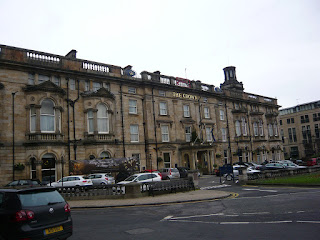Among my research books is a delightful book called Mrs Hurst Dancing, which is a collection
of watercolours by one Diana Sperling, who lived at Dynes Hall near Halstead in
Essex. This large country house along with its surroundings is the setting for
the sketches she made between 1816 and 1823 where she lived with her parents,
brothers and sister Isabella.
What I love about it is the insight it gives us to the
reality of how people lived in those days. There are a great many outdoor
scenes which show how the countryside must have looked then, and Diana has
drawn her family and acquaintances riding, driving, walking, fishing, skating
and a great many other activities, in all kinds of weather.
The sketches are often amusing, as well as telling, with
people falling off their mounts – donkeys and horses both, carriages coming to
grief, people falling into mud and streams, leaping ditches on horseback. The
family might go to an evening party on foot, braving the mud and carrying their
indoor shoes, or they would go divided among a single carriage and several
horses. Even the ladies went on horseback to a party!
The title of the book comes from one sketch called Mrs Hurst
Dancing, but almost all of the sketches have hand-written notes to say who the
people are and what they are doing. Interestingly, Diana writes of her mother
as “Mum” and her father as “Pappy”, but the Sperlings were local landowners
and, as it says in the introduction, “might be said to belong to the ranks of
the substantial gentry, the sort of well-to-do squires who dominated village
affairs”. These families were “untitled but locally prominent”. They might
originate as younger sons of greater families or spring from “cadet” branches
of the aristocracy.
Leaving the outdoors for another day, I’ve chosen some
indoor sketches that show unusual activities on the domestic front. They also
depict the rooms as they must have been, fairly open and without much
furniture. Rugs rather than carpets, and the pet dog and cat usually present.
Right at the top, we have the hilarious “Mrs Sperling murdering flies – assisted by her maid who received the dead and wounded. Dynes Hall.” I love the mirror and the looped curtains at the windows.
Here we have “Papering the saloon at Tickford Park,
September 2nd 1816”. The Van Hagen family, who were relations, owned
this house and Diana was clearly helping to paper the walls while on a visit.
Here we are again at the Van Hagens with “Mrs Van murdering
a spider, September 10th 1816, Tickford.” The ladies are dressing
when the spider interrupts the proceedings.
Finally, I could not resist putting in this one, with the
splendid staircase and lovely balusters. But the action is wonderful.
“May 25th.
Henry Van electrifying – Mrs Van, Diana, Harry, Isabella, Mum and HGS. Dynes
Hall.” I gather the object was to turn the electrifying machine strongly enough
for everyone who joined hands to get a shock! Fun for all, no doubt, though I
suspect the sensation was a mild one.
Elizabeth Bailey






.jpg)



















